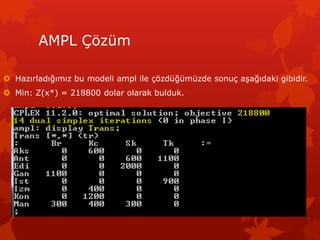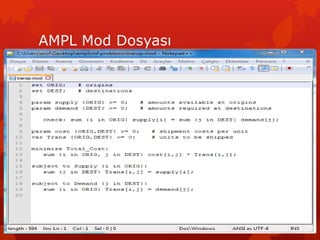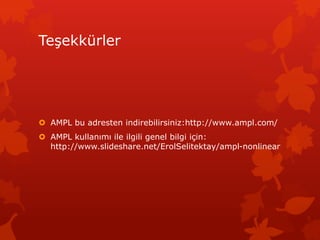Genel Bir Ula?t?rma Probleminin AMPL ?le ??z¨ąm¨ą
- 1. AMPL ?le Ula?t?rma Porblemi ??z¨ąm¨ą Erol Selitektay
- 2. Ama? ? Genel bir ?Ula?t?rma Probleminin? AMPL kullan?larak ??z¨ąm¨ąn¨ąn sa?lanmas?.
- 3. Problem ? Araba yedek par?alar? ¨ąreten bir ?irketin 4 ayr? b?lgede ¨ąretim fabrikalar? bulunmaktad?r. Bu fabrikalarda ?elik rulolar ¨ąretilmektedir. Fabrika ba??na ¨ąretilen ?elik rulolar?n miktar? a?a??daki tabloda g?sterildi?i gibidir. B?lge Rulo(ton) Bursa (Br) 1400 Kocaeli (Kc) 2600 Sakarya (Sk) 2900 Tekirda? (Tk) 2000
- 4. Problem ? Toplam 8900 ton olan ?elik rulolar?n a?a??daki tabloda g?sterilen otomobil fabrikalar?na ihtiya?lar? do?rultusunda g?nderilmesi gerekmektedir. Fabrika Rulo(ton) ?stanbul Otofab. 900 Konya Otofab. 1200 Aksaray Otofab. 600 ?zmir Otofab. 400 Antalya Otofab. 1700 G. Antep Otofab. 1100 Manisa Otofab. 1000 Edirne Otofab. 2000
- 5. Problem ? ?elik rulo ¨ąreten fabrikalardan otomobil fabrikalar?na ton ba??na ?elik rulonun ula??m maliyeti(dolar olarak) ?ekil C de g?sterildi?i gibidir. Bursa (Br) Kocaeli (Kc) Sakarya (Sk) Tekirda? (Tk) ?stanbul Otofab.(?st) 39 27 24 22 Konya Otofab.(Kon) 14 9 14 33 Aksaray Otofab.(Aks) 11 12 17 35 ?zmir Otofab.(?zm) 14 9 13 25 Antalya Otofab.(Ant) 16 26 28 32 G.Antep Otofab.(Gan) 82 95 99 100 Manisa Otofab.(Man) 8 17 20 24 Edirne Otofab.(Edi) 5 15 10 20
- 6. Problem ? Verilen de?erler g?z ?n¨ąne al?narak, ula??m maliyetinin en az olmas? ko?uluyla ?elik rulo fabrikalar?ndan otomobil fabrikalar?na ?elik rulo ta??ma plan? nas?l olmal?d?r?
- 7. ??z¨ąm ? Ula??m maliyetinin en az olmas? istenildi?i i?in, problemi minimum ama? fonksiyonu olacak ?ekilde ??zmeliyiz. ? ??? ??????? ?=1 ? ?=1
- 8. ??z¨ąm ? min: Z(x*) = 39*?st:Br + 27*?st:Kc + 24*?st:Sk + 22*?st:Tk + 14*Kon:Br + 9*Kon:Kc + 14*Kon:Sk + 33*Kon:Tk + ? 11*Aks:Br + 12*Aks:Kc + 17*Aks:Sk + 35*Aks:Tk + ? 14*?zm:Br + 9*?zm:Kc + 13*?zm:Sk + 25*?zm:Tk + ? 16*Ant:Br + 26*Ant:Kc + 28*Ant:Sk + 32*Ant:Tk + ? 82*Gan:Br + 95*Gan:Kc + 99*Gan:Sk + 100*Gan:Tk + ? 8*Man:Br + 17*Man:Kc + 20*Man:Sk + 24*Man:Tk + ? 18*Edi:Br + 10*Edi:Kc + 9*Edi:Sk + 5*Edi:Tk ? ? Not: ?st:Br k?saltmas?, Bursa fabrikas?ndan ?stanbul da ki otomobil ¨ąreticisine ta??nmas? gereken ton miktar?n? temsil ediyor.
- 9. ??z¨ąm ? Ama? fonksiyonumuz toplamda 32 tane de?i?enden olu?uyor. ? Ama? fonksiyonundan sonra k?s?tlar?m?z? belirlememiz gerekiyor. Bursa daki ?elik rulo ¨ąreticisi fabrikan?n g?nderebilece?i rulo miktar? 1400 ton. Bursa daki ?elik rulo ¨ąreticisi i?in k?s?t yazacak olursak; ? Br:?st + Br:Kon + Br:Aks + Br:?zm + Br:Ant + Br:Gan + Br:Man + Br:Edi <= 1400 ? ??? ˇÜ ?? ? = 1, ˇ , ?.? ?=1
- 10. ??z¨ąm ? Ayn? ?ekilde di?er ?elik rulo ¨ąreticileri i?inde k?s?tlar? yazacak olursak; ? Kc:?st +Kc:Kon + Kc:Aks + Kc:?zm + Kc:Ant + Kc:Gan + Kc:Man + Kc:Edi <= 2600 ? Sk:?st +Sk:Kon + Sk:Aks + Sk:?zm + Sk:Ant + Sk:Gan + Sk:Man + Sk:Edi <= 2900 ? Tk:?st +Tk:Kon + Tk:Aks + Tk:?zm + Tk:Ant + Tk:Gan + Tk:Man + Tk:Edi <= 2000
- 11. ??z¨ąm ? Ayr?ca otomobil ¨ąreticisi fabrikalar?nda alaca??m rulo miktarlar? i?inde k?s?t yazmam?z gerekiyor. ?stanbul da ki otomobil fabrikas?n?n alabilece?i ?elik rulo k?s?t?n? yazacak olursak; ? ?st:Br + ?st:Kc + ?st:Sk + ?st:Tk <= 900 ? ??? ˇÝ ?? ? = 1, ˇ , ?.? ?=1
- 12. ??z¨ąm ? Ayn? ?ekilde di?er otomobil ¨ąreticileri i?inde k?s?tlar? yazacak olursak; ? Kon:Br + Kon:Kc + Kon:Sk + Kon:Tk <= 1200 ? Aks:Br + Aks:Kc + Aks:Sk + Aks:Tk <= 600 ? ?zm:Br + ?zm:Kc + ?zm:Sk + ?zm:Tk <= 400 ? Ant:Br + Ant:Kc + Ant:Sk + Ant:Tk <= 1700 ? Gan:Br + Gan:Kc + Gan:Sk + Gan:Tk <= 1100 ? Man:Br + Man:Kc + Man:Sk + Man:Tk <= 1000 ? Edi:Br + Edi:Kc + Edi:Sk + Edi:Tk <= 2000
- 13. ??z¨ąm ? Elimizde her ?elik rulo ¨ąreticisi ve otomobil fabrikas? i?in toplamda 10 tane k?s?t oldu. E?er k?s?tlara her bir de?i?ken i?in negatif olmama ko?ulunu da eklersek, elimizde ula?t?rma problemi i?in lineer bir problem olmu? olur.
- 14. AMPL ??z¨ąm Modeli ? Ula?t?rma problemimiz i?in bir ??z¨ąm modeli bulmam?z gerekiyor. Bunun i?in ?u yolu izleyebiliriz. Elimizde iki tane ana nesne var. Birisi kaynak yani ?elik rulo ¨ąreten fabrikalar, di?eri ise ula?t?r?lmas? gereken yerler yani ?elik rulolar? kullanacak otomobil ¨ąreticileri. Bunlar? iki ayr? dizi olarak d¨ą?¨ąnebiliriz. Rulo ¨ąretici fabrikalara TEDARIK, bu ¨ąr¨ąnleri kullanacak fabrikalara da TALEP dizisi olarak d¨ą?¨ąnebiliriz.
- 15. AMPL ile ??z¨ąm Modeli ? Bu durumda iki ana parametremizi ?u ?ekilde g?sterebiliriz; ? param supply {TEDARIK} >= 0; ? param demand {TALEP} >= 0; ? Tedarik ve talep durumlar? i?in ??yle bir denklem yazabiliriz; ? check: sum {i in TEDARIK} supply[i] = sum {j in TALEP} demand[j];
- 16. AMPL ile ??z¨ąm Modeli ? Bu denklemde belirtilen tedariklerin toplam? taleplerin toplam?na e?it olmak zorundad?r. Bu ko?ul sa?lanmad??? s¨ąrece olas? bir ??z¨ąm m¨ąmk¨ąn de?ildir. ? Her talep ve arz kombinasyonu i?in bir ula??m maliyeti ve ula??m miktar?n? sembolize eden bir de?i?kene ihtiyac?m?z var. Bu ko?ulu da ?u ?ekilde g?sterebiliriz. ? param maliyet {TEDARIK, TALEP} >= 0; ? var Trans {TEDARIK, TALEP} >= 0; ? Her belirli TEDARIK i ve TALEP j i?in toplam maliyeti ?u ?ekilde g?sterebiliriz. ? Maliyet[i,j] * Trans[i,j]
- 17. AMPL ile ??z¨ąm Modeli ? T¨ąm bu denklem k¨ąmelerini bir ?ekilde g?sterirsek ama? fonksiyonumuzu ?u ?ekilde g?sterebiliriz: ? minimize Toplam_Maliyet: ? sum {i in TEDARIK, j in TALEP} maliyet[i,j] * Trans [i,j]; ? Ayn? ?ekilde k?s?tlar?m?z? g?sterecek olursak; ? Subject to Supply {i in TEDARIK } : ? sum {j in TALEP} Trans[i,j] = supply[i]; ? Subject to Demand {j in TALEP}: ? sum {i in TEDARIK} Trans[i,j] = demand[j];
- 18. AMPL ??z¨ąm ? Haz?rlad???m?z bu modeli ampl ile ??zd¨ą?¨ąm¨ązde sonu? a?a??daki gibidir. ? Min: Z(x*) = 218800 dolar olarak bulduk.
- 20. AMPL Mod Dosyas?
- 21. Te?ekk¨ąrler ? AMPL bu adresten indirebilirsiniz:http://www.ampl.com/ ? AMPL kullan?m? ile ilgili genel bilgi i?in: http://www.slideshare.net/ErolSelitektay/ampl-nonlinear



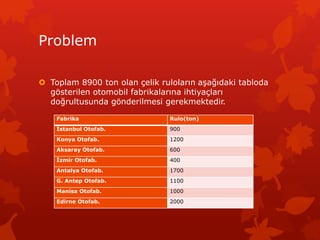
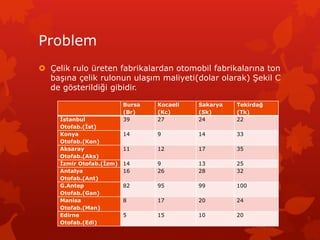
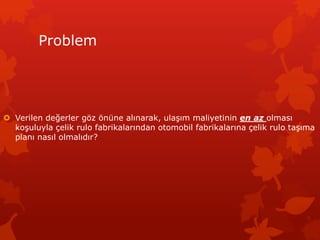
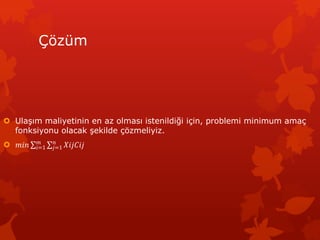
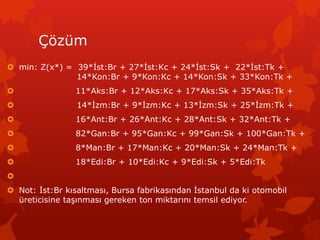

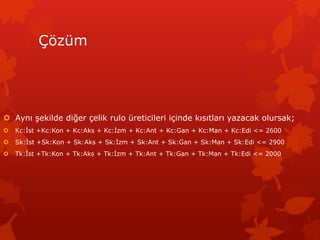
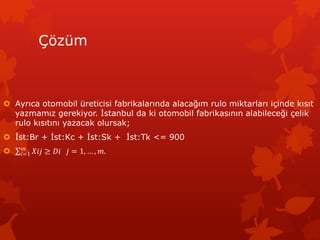
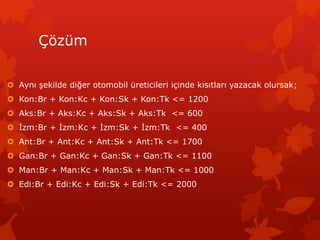
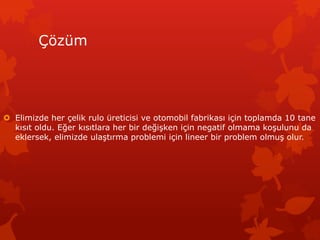
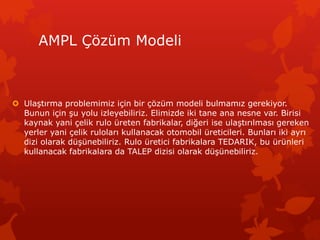
![AMPL ile ??z¨ąm Modeli
? Bu durumda iki ana parametremizi ?u ?ekilde g?sterebiliriz;
? param supply {TEDARIK} >= 0;
? param demand {TALEP} >= 0;
? Tedarik ve talep durumlar? i?in ??yle bir denklem yazabiliriz;
? check: sum {i in TEDARIK} supply[i] = sum {j in TALEP} demand[j];](https://image.slidesharecdn.com/ampltransportation-130627083231-phpapp02/85/Genel-Bir-Ulastirma-Probleminin-AMPL-Ile-Cozumu-15-320.jpg)
![AMPL ile ??z¨ąm Modeli
? Bu denklemde belirtilen tedariklerin toplam? taleplerin toplam?na e?it
olmak zorundad?r. Bu ko?ul sa?lanmad??? s¨ąrece olas? bir ??z¨ąm m¨ąmk¨ąn
de?ildir.
? Her talep ve arz kombinasyonu i?in bir ula??m maliyeti ve ula??m miktar?n?
sembolize eden bir de?i?kene ihtiyac?m?z var. Bu ko?ulu da ?u ?ekilde
g?sterebiliriz.
? param maliyet {TEDARIK, TALEP} >= 0;
? var Trans {TEDARIK, TALEP} >= 0;
? Her belirli TEDARIK i ve TALEP j i?in toplam maliyeti ?u ?ekilde
g?sterebiliriz.
? Maliyet[i,j] * Trans[i,j]](https://image.slidesharecdn.com/ampltransportation-130627083231-phpapp02/85/Genel-Bir-Ulastirma-Probleminin-AMPL-Ile-Cozumu-16-320.jpg)
![AMPL ile ??z¨ąm Modeli
? T¨ąm bu denklem k¨ąmelerini bir ?ekilde g?sterirsek ama? fonksiyonumuzu
?u ?ekilde g?sterebiliriz:
? minimize Toplam_Maliyet:
? sum {i in TEDARIK, j in TALEP} maliyet[i,j] * Trans [i,j];
? Ayn? ?ekilde k?s?tlar?m?z? g?sterecek olursak;
? Subject to Supply {i in TEDARIK } :
? sum {j in TALEP} Trans[i,j] = supply[i];
? Subject to Demand {j in TALEP}:
? sum {i in TEDARIK} Trans[i,j] = demand[j];](https://image.slidesharecdn.com/ampltransportation-130627083231-phpapp02/85/Genel-Bir-Ulastirma-Probleminin-AMPL-Ile-Cozumu-17-320.jpg)
